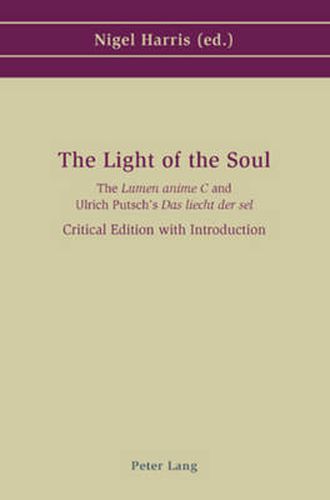Readings Newsletter
Become a Readings Member to make your shopping experience even easier.
Sign in or sign up for free!
You’re not far away from qualifying for FREE standard shipping within Australia
You’ve qualified for FREE standard shipping within Australia
The cart is loading…






This is the first edition of the fourteenth-century Lumen anime C and of its German translation Das liecht der sel, completed in 1426 by Ulrich Putsch, Bishop of Brixen (Bressanone) in the South Tyrol. The two works are theological compendia for use in homiletic and catechetical contexts, and teach their intended readership much about basic Christian doctrine and morality, with a special emphasis on the Virgin Mary. Their didactic method makes particular use of nature exempla and of (frequently spurious) quotations from authorities. Both were highly influential in late-medieval Germany, especially in Austria and Bavaria, but their important role in conveying the insights of late-medieval Catholicism to an increasingly numerous lay audience has yet to be fully appreciated. The present edition should facilitate this and several other necessary re-assessments. Critical texts of the Latin and German versions are printed in parallel. They are preceded by an introduction which offers, for each text in turn, descriptions of its manuscripts, an account of its textual history, and an evaluation of previous research - and, in respect of Das liecht der sel, also covers the biography of Ulrich Putsch.
$9.00 standard shipping within Australia
FREE standard shipping within Australia for orders over $100.00
Express & International shipping calculated at checkout
This is the first edition of the fourteenth-century Lumen anime C and of its German translation Das liecht der sel, completed in 1426 by Ulrich Putsch, Bishop of Brixen (Bressanone) in the South Tyrol. The two works are theological compendia for use in homiletic and catechetical contexts, and teach their intended readership much about basic Christian doctrine and morality, with a special emphasis on the Virgin Mary. Their didactic method makes particular use of nature exempla and of (frequently spurious) quotations from authorities. Both were highly influential in late-medieval Germany, especially in Austria and Bavaria, but their important role in conveying the insights of late-medieval Catholicism to an increasingly numerous lay audience has yet to be fully appreciated. The present edition should facilitate this and several other necessary re-assessments. Critical texts of the Latin and German versions are printed in parallel. They are preceded by an introduction which offers, for each text in turn, descriptions of its manuscripts, an account of its textual history, and an evaluation of previous research - and, in respect of Das liecht der sel, also covers the biography of Ulrich Putsch.